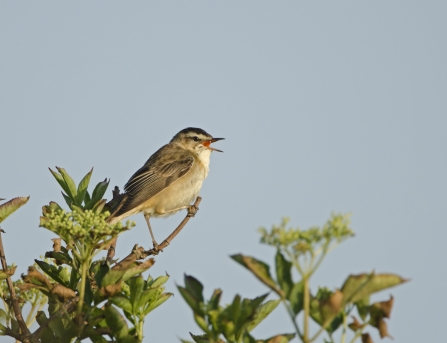
Sedge warbler. Image by: David Tipling/2020VISION.

Sedge warbler. Image by: David Tipling/2020VISION.
Easily accessible by either the Arriva x18 or x20 bus serves - which serve Newcastle, Morpeth, Berwick and Alnwick respectively - the range of habitats here help make it one of the most dynamic beauty spots in the region. With its pleasant mix of wet grassland, scrub and sand dune environments, as well as looking rather lovely, the location provides an irresistible draw to both migrant birds and those who admire them.
Indeed, over recent weeks alone, I have observed myriad seasonal treasures at Druridge including; common crane, great white egret, no less than two spoonbills and, better still, a red-rumped swallow – a rare, colourful and, in my case, entirely unexpected visitor from Southern Europe. With Druridge solidifying its prestigious reputation further with sightings of red kite and hooded crow, the latter a species more often associated with the highlands of Scotland, and not coastal Northumberland.
Things continued along a similar, exciting vein yesterday, upon my latest visit. My arrival at the reserve met with the awe-inspiring sight of an osprey circling high above the floods. My first ever in the county no less, and a sight I will not soon forget; largely due to its beauty. The raptors pale feathers gleaming as it gained height; riding the afternoon thermals as, alongside its escort of disgruntled carrion crows, it gradually faded from sight. This bird, fresh from Africa, a fitting precursor of what was to come upon further exploration of the reserve and its surrounds.
With each and every step along the coastal road, the signs of seasonal change became more and more apparent. Randy tortoiseshell butterflies jostling for position amid the now rejuvenated grass, a tree bumblebee – my first in almost two years – and a rather regal looking stonechat singing from the pinnacle of a stunted hawthorn, to name but a few. Sights representative of the spring season that all may enjoy here, hopefully under the glaring sun, as I did. This fresh theme extending, also, to the birds: with the otherworldly song of a grasshopper warbler, secreted amid the dunes, and numerous willow warblers voicing their virility from the upper echelons of the poolside willows. Yet more new arrivals.
Speaking of the pools, migrants could be seen here too, or at least heard, this being the case with the year’s first sedge warbler singing its scratchy song from the nearby scrub. Here the chattering of hirundines – sand martins, swallows and house martins – filled the sky as almost one hundred birds fed on newly emerged flies. The swallows in particular looking supreme; appearing almost sapphire in the midday sunlight. Their aerial antics largely ignored by the residents of the pools – the shoveler, wigeon, teal and gadwall – who fed, uninterrupted during my stay. The myriad colours on show here, on the water, almost as enrapturing as those above: from the pristine white of the little egrets stalking in the shallows to the metallic green of the lapwings languishing on the peripheries.
An hour passed quickly as I scoured the pools, keen to unearth yet more of spring’s finest. A touch of patience paying off with sightings of whimbrel – a close relative of our resident and much more familiar curlew – and later, a male wheatear standing proudly atop a fence post. The latter watching intently before fleeing – alongside most of the pools smaller residents – as a marsh harrier glided, purposefully, into view. The king of the skies here and a glorious sight for the others, like me, watching from the hide. Though I suspect a far less thrilling sight for the snipe and meadow pipits doing their best to evade capture.
Departing Druridge, one more surprise lay in store. The shrill cry of a vole from within the tall grass heralding the arrival of another predator: a weasel. The encounter over in a jiffy, as so often they area, with the mustelid breaking cover only briefly before slinking back into the shadows, departing, and leaving me to do the same - a smile fixed to my face following a day of non-stop action.
*For those getting the bus to Druridge, both the services mentioned above deliver you to Widdrington Village a short way west of the reserve itself. The walk from here is a joyous one, through scenic farmland boasting its own cast of endearing critters. So be sure to keep your eyes peeled for yellow wagtail and other delightful visitors over the coming weeks*